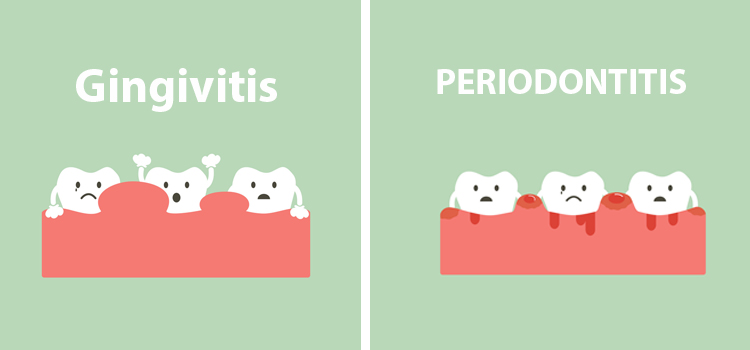Gingivitis or Periodontitis, you never want these two words to come out of your dentist’s mouth when you go for a check-up. These two gum diseases don’t just spike your oral bill but they are serious. Let’s get into the Gingivitis vs Periodontitis debate to find what these are all about.
About Gingivitis
Gingivitis refers to the inflammation of the gums. It starts with plaque accumulating between the teeth. It makes your teeth weaker and they bled whenever you brush your teeth. The teeth remain firmly planted but your gums feel irritated.
Common signs include red and swollen gums. Gum bleeding while brushing is also an indication of this oral problem. The good news is its mild gum disease and it does not cause bone damage.
Good hygiene and oral health habits like flossing, brushing twice a day, and using mouthwash can prevent and reverse Gingivitis.
About Periodontitis
Periodontitis refers to a serious Gingiva infection that permanently damages the gums and jawbone. When this disease develops, the inner layer of the gum and bones start pulling away from the teeth. Small spaces are formed between the teeth and gums. This makes room for debris to settle and infect your teeth further.
The immunity system of the body takes the lead to fight the bacteria as the plaque spreads and grows under the gum line. This fight is not easy. The poison and toxins produced by the bacteria present inside the plaque teams with the good enzymes. This breaks down the bones and collective tissues holding the teeth in place.
Periodontitis reaches its aggressive stage when pockets deepen destroying the gums and bones. There will come a point when your teeth won’t remain anchored in place and loosen up. Signs and symptoms of mouth problems like this include bleeding, swollen, and red gums, poor tooth alignment, pain while chewing, and receding gums.
Understanding Gingivitis Vs Periodontitis
Gingivitis and Periodontitis are often mistaken. Both are gum diseases and stages of a periodontal condition. However, both are different conditions. Gingivitis is the early stage of Periodontitis. If not treated in time, it can develop into Periodontitis. You should be able to spot the symptoms early on with careful oral hygiene.
Gingivitis Symptoms
This disease changes your gums. Healthy gums are tightly fitted around the teeth and they are pale pink. When your gums are affected by this disease, they become puffy and dark red similar to the effects of smoking.
Gum bleeding while brushing your teeth is another common symptom. The most noticeable sign of Gingivitis is bad breath leaving an unpleasant taste in your mouth.
Periodontitis Symptoms
You enter into the periodontal stage when your gums become painful and it gets hard to ignore the pain. The gums become tender and easily bleed.
Notice your teeth and they will appear larger than they. This is when gums start to pull away from the teeth. New spaces start developing between the teeth. Some even complain about pus forming between those spaces.
The most unusual symptom is noticing your teeth fit differently when you bite food. Chewing becomes highly painful and bad breath gets worse.
What’s the Treatment?
Gingivitis vs Periodontitis treatment includes surgical and non-surgical options. When you are at the Gingivitis stage, start paying attention to your oral health. Follow these measures instantly:
- Brush twice a day
- Use soft-bristled toothbrush
- Get an electric toothbrush
- Rinse your mouth with a mouthwash
- Floss daily
These oral health tips alone won’t work. Just like teeth straightening requires a dental appointment, so does gingivitis removal. The dentist will recommend treatment depending on your condition.
Non-Surgical Treatment Options
The dentist will use an instrument to remove bacterial from the gums and teeth. They might employ root planning to remove build-up plaque and discourage further development. Lastly, once the dentist has cleaned up your teeth, they will write you a prescription for oral antibiotics if there is an infection.
Surgical Treatment Options
Surgery is performed in case of aggressive Periodontitis. Before the dentist begins the procedure, they will ask you certain questions about your medical history. If you have diabetes, history of heart disease, or high blood pressure problem, let them know. It’s important to reveal accurate information as this affects the outcome.
Common surgeries for treating Periodontitis include tissue regeneration, bone graft, flap surgery, and tissue graft. These treatments are complex and expensive.
Conclusion
The best way of avoiding gum diseases altogether is to practice good oral hygiene. Even though Gingivitis can be treated, it still leaves an impact on your oral health. Look for the symptoms right away. Schedule an appointment with the dentist right away even if you notice minor signs.
The dentist will recommend an oral health plan which you must follow strictly. If you have further questions about Gingivitis Vs Periodontitis, let us know in comments.




